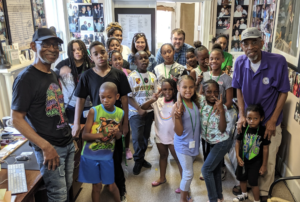To love Nashville is to grieve Nashville — especially if you are a creative, and especially if you are broke. The funky corners where working class musicians have found voice and community are increasingly sparse. Many of our quirky, scruffy, DIY spaces have become casualties of development. For many of us, waning affordability correlates with a waning sense of place and trust in our city. For white artists like myself, this growth is overwhelming and new. But on Jefferson Street in North Nashville, this is an obvious continuation of a long, systemically racialized American story.
The Original Music Row
Long before Nashville was home to Music Row, pop country, and Broadway Honky Tonks, she was Music City. Long before George Jones and Carrie Underwood and Taylor Swift and even our alt-country heroes like John Prine, she was Music City — and she was Black. In the late 1800’s, the Fisk Jubilee Singers, lead by Ella Sheppard (born enslaved on Andrew Jackson’s Hermitage in 1851), performed for Queen Victoria. After hearing the revolutionary Gospel choral arrangements performed by singers of this Historically Black University, the queen exclaimed that they sounded so beautiful that they must be from Music City. Of course, they were.
Meet Lorenzo
A century and a half later, there is one man who, at 80 years old, is dedicating his life to keeping the original heart and legacy of our city alive. With soft eyes, and a radiant smile, Lorenzo treats everyone who walks through the door like family. Mr. Lorenzo Washington started the Jefferson Street Sound Museum out of his home (a stones throw away from Fisk University) in 2010. As a Nashville native, Mr. Washington grew up in the heyday of Nashville’s Blues, Soul, Jazz, and Rock n’ Roll when the neighborhood was rich and loaded with venues for Black performers such as Ray Charles, Etta James, Little Richard, and Jimi Hendrix, who found his voice as a guitarist on Jefferson Street.
In his book Rising Above, Washington states “you wouldn’t know it to look at Jefferson Street now, but at the height of its popularity, it had over 600 homes, businesses, and clubs. It was the only street in Nashville that we in the Black community could call “our street.” It was exciting just to walk down Jefferson Street and see people cooking up soul food and barbecue in their front yards.”’
From the 1940’s through the 1970’s, one could be on foot and experience blocks worth of artistic community and entertainment. There was the Tiki Lounge on 4th and Jefferson, Gants Club on 19th and Jefferson, The Flame Room, Hap Holidays Club, Brute Hayes Club, The Zanzibar Club, The Voters Club, Club Revolt, James Robertsons, The Ebony Circle Lounge, and so many more.
As an artist the in (largely white, largely transplant) Americana community, I’ve grieved the loss of some of the sacred spaces that have become casualties of Nashville becoming an “it city.” And while grief is not a comparison game, it’s eye opening to learn more about Jefferson Street and the extreme, systemic, and racially charged removal of their live music community. Like thriving Black communities all over the country, Jefferson Street’s personality as a cultural center was ravaged with the expansion of Interstate 40 in the 1970s.
Lorenzo was there before and after this tragedy, and has dedicated his life to keeping the legacy of Jefferson Street, from the 1940’s-1070’s alive, and strives to pair it with inclusive revitalization that honors the roots of the community. Each corner of the museum is covered in prints of musicians, maps of the street, venues and clubs. He has designed a poster of a tree, the trunk being Jefferson Street, and on each branch housing the historical clubs. To be in the space he has created, is to truly see the century-spanning musical foundation the Black community has built here, unsung heroes of the city we love.
History Repeating
When one learns the history of Jefferson Street, and the culture that was systemically robbed by racist city planning, one can’t help but notice the pattern repeating itself. As developers move in and crowd the predominantly Black neighborhood they had previously demonized, it hurts like hell to see. It is not fair, and it is our moral responsibility as community members to stand in the place where our city’s legacy began, give credit where credit is due, and support the work of Jefferson Street Sound Museum.
How To Support The Mission of JSS
You can help keep JSS alive with a tax-deductible donation to Jefferson Street Sound Museum, on their website: https://www.jeffersonstreetsound.com/donate
And make sure to drop in to the museum on a Saturday between 11-4 to enjoy a tour from the man himself, Lorenzo Washington, and purchase a copy of his book, Rising Above: The Lorenzo Washington Story.
To visit Fanny’s online store, visit: https://fannys-house-of-music.myshopify.com/
To learn more about how you can support Fanny’s in fostering a safe, multi-generational arts space, visit https://www.fannysschoolofmusic.org
Blog by Georgia English / a Nashville-based musician, writer, illustrator, and educator.





